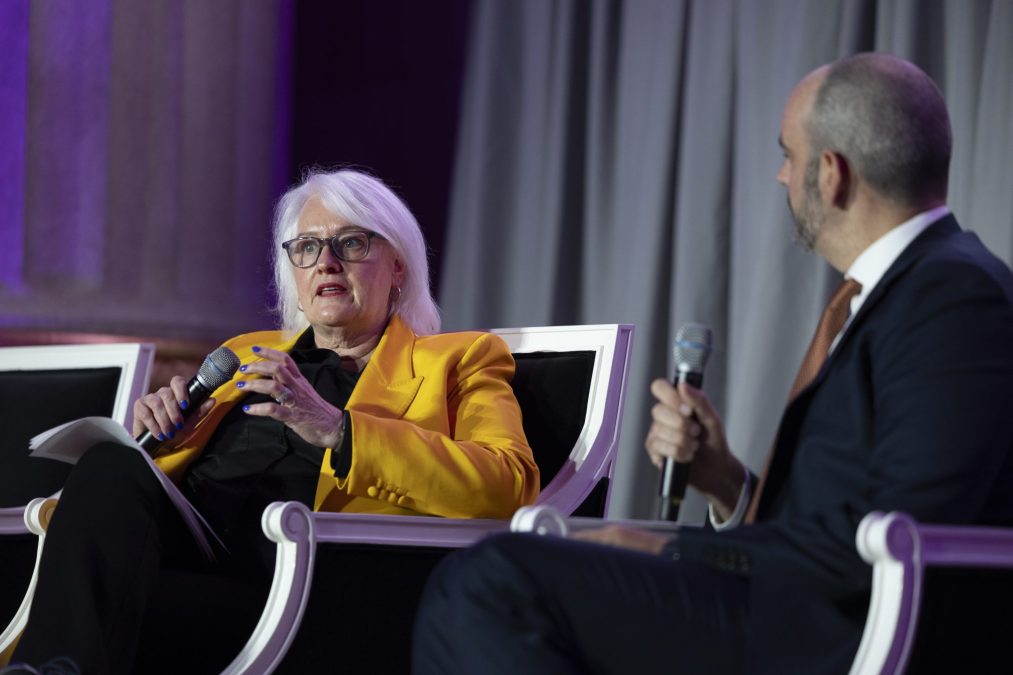Federal CIO: The TMF has been vital to government’s improved cybersecurity stature

The federal government has made notable strides in modernizing its cyber defenses since President Joe Biden signed executive order 14028 in May 2021, Federal CIO Clare Martorana said Wednesday.
But without the Technology Modernization Fund as a mechanism to kickstart agency modernization in areas like zero trust, multi-factor authentication and identity management, progress around federal cybersecurity would likely be in a much different place than it is today, Martorana suggested in an onstage interview at CyberTalks, presented by CyberScoop.
The numbers do a good job of explaining it.
“Since 2021 the Biden-Harris administration has invested $935 million in 56 projects across 34 agencies” using the TMF, Martorana said. “92% of this funding has helped to address cybersecurity needs across the federal ecosystem. The TMF Board has invested over $860 million in 45 projects that help address immediate security gaps and elevate the foundational cybersecurity of our federal agencies.”
On top of many federal IT and cybersecurity mandates— like those enumerated in the 2021 order — not receiving associated funding, traditional government appropriations cycles often fail to keep up with the rapid pace at which cyber threats emerge and agencies’ need to innovate and modernize to defend against them.
“We can’t fund cybersecurity and we can’t fund IT in the challenging environment that we are in when our funding is not meeting the speed that agencies need to remediate challenges that they have,” Martorana told FedScoop, explaining that continuing resolutions and “these long budget processes are really challenging for us in the IT and cyber community.”
The federal CIO continued: “We need to be nimble. We need to be able to invest when we have urgent issues. If we find things in the supply chain that need to be ripped and replaced, it is essential that we have agile funding that is available to federal agencies overseen by a board that manages projects in the most meaningful way.”
And with the TMF, she said, “we check them up front, we look at the technical architecture. We make sure the vendor contracts are in place. We make sure the personnel is capable at the agency. We fund and then we manage on a quarterly basis. We change as milestones change.”
On top of that, those projects are said to be seeing a much higher rate of success than traditional large-scale government IT acquisitions in delivering results on time and on budget. Robin Carnahan, head of the General Services Administration, told FedScoop in an interview at ACT-IAC’s Imagine Nation ELC 2024 conference this week that 80% of TMF projects have been deemed successful in that regard, compared to just 13% of IT projects funded in a traditional manner — a difference she called “profound.”
Carnahan echoed the notion that typical government budget cycles can’t keep up with the needs of technology transformation.
“One of the big problems … that we see is technology advances happen quick, and budget cycles don’t always align with that,” she said. “And so this is a way to be able to really keep up with the speed of need.”
Despite that, the administration has faced an uphill battle in convincing Congress to continue funding the TMF since it received a $1 billion lump sum as part of the American Rescue Plan in 2021. Most recently, in fiscal 2024 appropriations, Congress zeroed funding out for the year and called for $100 million of that previous money to be rescinded. Appropriators have previously taken issue with the TMF’s repayment model, which the GSA and the Office of Management and Budget have since updated.
Federal technology leaders like Martorana and Carnahan are persistent though, continuously advocating for additional funding to sustain the program.
Carnahan told FedScoop on Tuesday: “I think members of Congress are increasingly seeing that this is a successful program when you have folks who understand technology, who are making the decisions about where to invest when you’re able to make these investments outside of the normal budget cycle.”
And Wednesday, Martorana appealed to her industry partners gathered at CyberTalks to join in the push.
“My ask to every vendor and everybody in this audience: If you have an opportunity to speak to anyone in Congress, please encourage them to fund the TMF. If we don’t have these levers available to agencies, we will continue to be challenged,” she said.
Martorana, who’s nearing the end of her time as the top federal IT official as the Biden administration comes to a close, concluded: “Please be an advocate for TMF. We will continue to improve the process to make sure that we can meet the needs of agencies. But that’s my real clarion call. As I depart my role as federal CIO soon, please make sure that you set up the federal ecosystem for success in the future.”






